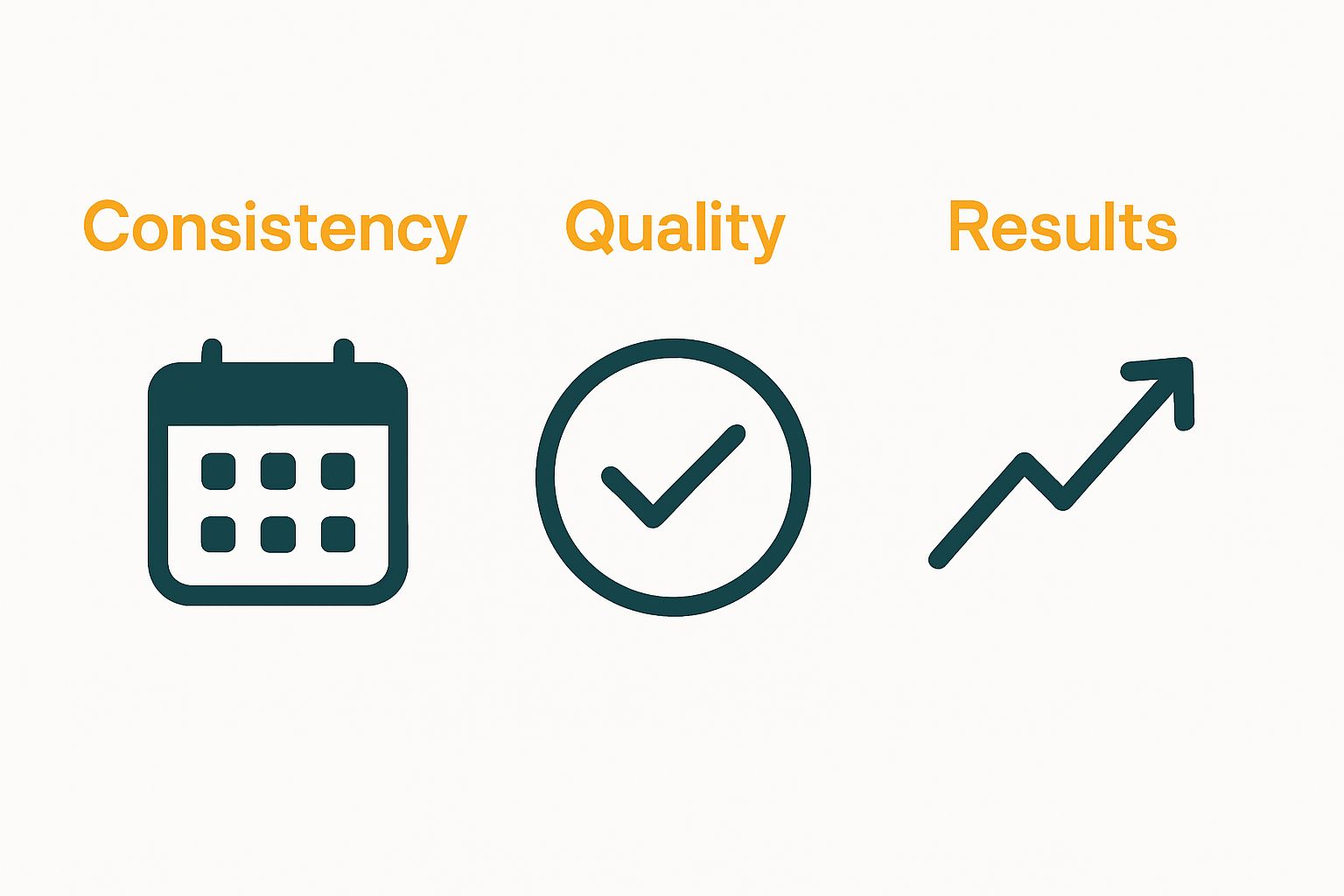Understanding Your Content Marketing Checklist for Success
- Eddie The Chef

- Oct 8
- 9 min read

Most businesses know they need content to connect with their audience, but many still struggle to turn ideas into results. Here is something wild—companies using structured content planning are up to 300% more likely to see higher engagement rates. It sounds like just another list to tick off, but these checklists actually become powerful tools that reshape how you reach and win over your customers.
Table of Contents
Quick Summary
Takeaway | Explanation |
Content checklists enhance strategic clarity | Structured checklists guide businesses in aligning content with broader marketing goals and brand messaging. |
Improved quality control through guidelines | Checklists establish clear standards to ensure consistency and prevent miscommunication in content creation. |
Facilitates collaboration among teams | A shared checklist reduces oversights and aligns efforts, enhancing team performance in content production. |
Dynamic tool for continuous improvement | Checklists are not static; they allow businesses to adapt strategies based on performance metrics and audience feedback. |
Boosts engagement through targeted content | By defining audience personas and goals, businesses can create content that resonates deeply with specific target groups. |
What is a Content Marketing Checklist and Why Use It?
A content marketing checklist serves as a strategic roadmap designed to guide businesses through the complex process of creating, distributing, and optimizing content that resonates with their target audience. Unlike generic task lists, these checklists provide a systematic approach to content development, ensuring every critical element receives proper attention and alignment with broader marketing objectives.
The Strategic Purpose of Content Marketing Checklists
Content marketing checklists transform abstract marketing strategies into actionable, measurable steps. Research from Content Marketing Institute reveals that businesses using structured content planning processes are significantly more likely to achieve their marketing goals. The checklist becomes a comprehensive framework that addresses multiple dimensions of content creation:
Ensuring consistent brand messaging
Maintaining high-quality content standards
Tracking performance metrics
Identifying potential improvement areas
Practical Benefits for Australian Businesses
For regional businesses in sectors like automotive, hospitality, and professional services, a well-constructed content marketing checklist offers multiple advantages. It helps organisations move beyond sporadic content creation towards a more strategic and deliberate approach. Discover how content strategy transforms marketing efforts by providing clarity, reducing inefficiencies, and creating a repeatable process that can be refined over time.
The checklist acts as a collaborative tool that aligns team efforts, reduces oversight risks, and establishes a standardised workflow. Whether you are a small medical practice in Gippsland or a growing digital marketing agency, having a structured approach ensures that every piece of content serves a specific purpose and contributes to your overall business objectives.
Ultimately, a content marketing checklist is not just a bureaucratic document but a dynamic instrument that helps businesses navigate the complex landscape of digital communication, transforming sporadic content efforts into a cohesive, result-driven strategy.
The Importance of a Content Marketing Checklist for Businesses
Content marketing checklists represent more than mere administrative tools they are critical strategic assets that transform how businesses approach digital communication and audience engagement. By providing a structured framework, these checklists enable organisations to systematically develop, execute, and evaluate their content strategies with precision and intentionality.
Strategic Alignment and Business Objectives
Research from McKinsey demonstrates that businesses with aligned marketing strategies experience 20% higher revenue growth compared to their competitors. A comprehensive content marketing checklist ensures that every content piece directly supports broader business goals, creating a cohesive narrative that resonates with target audiences. Learn more about marketing strategy fundamentals to understand how strategic alignment drives business success.
Risk Mitigation and Quality Control
For regional Australian businesses across industries such as automotive, hospitality, and professional services, content marketing checklists serve as critical risk management tools. They help organisations maintain consistent quality standards by establishing clear guidelines and verification processes. Key risk mitigation aspects include:
Preventing brand messaging inconsistencies
Ensuring legal and regulatory compliance
Maintaining editorial standards
Reducing potential miscommunication errors
Performance Tracking and Continuous Improvement
Content marketing checklists are not static documents but dynamic instruments of continuous improvement. They enable businesses to systematically track content performance, identify improvement opportunities, and adapt strategies in real time. By incorporating metrics tracking, review processes, and feedback mechanisms, organisations can create an adaptive and responsive content ecosystem that evolves with changing market dynamics and audience preferences.

Ultimately, a well-designed content marketing checklist transforms content creation from a haphazard activity into a strategic, measured approach that drives meaningful business outcomes and supports long-term growth objectives.
The following table provides a quick view of research statistics and data points mentioned throughout the article, giving context to the impact of content marketing checklists for Australian businesses.
Data Point | Source/Context | Statistic/Outcome |
Structured content planning increases engagement rates | Research from Content Marketing Institute | Up to 300% improvement |
Strategic marketing alignment drives higher revenue growth | McKinsey research | 20% higher revenue growth |
Structured content strategies increase marketing objective achievement | Gartner research | 60% more likely |
Small businesses see higher engagement with structured content strategies | HubSpot research | 300% higher engagement rates |
Key Components of an Effective Content Marketing Checklist
An effective content marketing checklist transcends a simple to-do list, functioning as a comprehensive strategic framework that guides businesses through the intricate process of content creation, distribution, and optimization. By incorporating multiple critical dimensions, these checklists transform complex marketing objectives into actionable, measurable steps.
Strategic Planning and Audience Alignment
Research from Content Marketing Institute highlights that successful content strategies begin with deep audience understanding. A robust content marketing checklist must include comprehensive audience research and segmentation components that enable businesses to craft highly targeted, resonant content. Learn more about content optimization strategies to enhance your marketing approach.
Key strategic planning elements should encompass:
Detailed audience persona development
Comprehensive competitive landscape analysis
Clear content goals and key performance indicators
Alignment with broader business objectives
Content Development and Quality Assurance
The core of an effective content marketing checklist lies in its ability to maintain consistent quality while enabling creative flexibility. This involves establishing rigorous yet adaptable guidelines that address multiple content dimensions. Businesses must develop comprehensive review processes that evaluate content across critical parameters:
Brand voice consistency
Technical accuracy
SEO optimization
Compliance with legal and ethical standards
Visual and narrative engagement
Performance Measurement and Continuous Optimization
A dynamic content marketing checklist incorporates robust tracking and evaluation mechanisms. By integrating detailed performance metrics and feedback loops, businesses can transform their content strategy from a static process to an adaptive, data-driven approach. This continuous improvement framework allows organisations to rapidly identify successful content patterns, rectify underperforming strategies, and maintain a competitive edge in rapidly evolving digital landscapes.
Ultimately, an effective content marketing checklist serves as a strategic compass, guiding businesses through the complex terrain of digital communication and audience engagement with precision and purpose.
Below is a table summarising the key components of an effective content marketing checklist, helping clarify how each element contributes to strategic content planning for Australian businesses.
Component | Description |
Audience Persona Development | Creation of detailed customer profiles to target content effectively |
Competitive Landscape Analysis | Assessing what competitors are doing to identify gaps and opportunities |
Content Goals and KPIs | Defining clear objectives and metrics for content performance |
Business Objectives Alignment | Ensuring every content piece supports wider business goals |
Brand Voice Consistency | Maintaining a unified tone and message across all content |
Technical and SEO Accuracy | Ensuring content is correct, optimised, and complies with search engine guidelines |
Legal and Ethical Compliance | Adhering to relevant laws, regulations, and ethical standards for each industry |
Visual and Narrative Engagement | Using engaging visuals and storytelling to capture and retain audience attention |
Performance Tracking and Feedback Loops | Continuously measuring outcomes and refining strategies based on data and audience insights |
How a Content Marketing Checklist Enhances Your Strategy
A content marketing checklist acts as a strategic amplifier, transforming theoretical marketing concepts into practical, executable actions that drive tangible business outcomes. By providing a structured approach to content development, these checklists help organisations navigate the complex digital marketing landscape with precision and intentionality.
Strategic Alignment and Operational Efficiency
Research from Gartner indicates that businesses with structured content strategies are 60% more likely to achieve their marketing objectives. A comprehensive content marketing checklist serves as a strategic roadmap, ensuring every content piece is meticulously planned, created, and evaluated. Explore our ultimate business marketing strategy insights to understand how strategic frameworks drive success.
Critical efficiency enhancement aspects include:
Streamlining content production workflows
Reducing redundant creative efforts
Enabling rapid content iteration
Facilitating cross-team collaboration
Performance Optimization and Continuous Improvement
Content marketing checklists function as sophisticated performance management tools that enable businesses to systematically track, analyse, and refine their content strategies. By incorporating detailed metrics and feedback mechanisms, organisations can develop a data-driven approach to content creation that responds dynamically to audience engagement and market trends.
Key performance optimization components encompass:
Comprehensive content performance tracking
Audience engagement metric analysis
Continuous strategy refinement
Identification of high-performing content patterns
Risk Mitigation and Quality Control
Beyond strategic and performance benefits, content marketing checklists play a crucial role in maintaining consistent brand quality and mitigating potential communication risks. They establish clear guidelines that ensure content remains aligned with brand voice, regulatory requirements, and strategic objectives, protecting the organisation’s reputation and messaging integrity.
Ultimately, a well-designed content marketing checklist transforms content creation from a reactive process into a proactive, strategic instrument that drives meaningful business growth and audience connection.
Real-World Examples of Content Marketing Checklists in Action
Content marketing checklists are not theoretical constructs but practical tools that transform how businesses approach digital communication. By examining successful implementations across various industries, organisations can understand how these strategic frameworks drive tangible marketing outcomes and business growth.
Small Business Content Strategy Implementation
Research from HubSpot reveals that small businesses implementing structured content strategies experience 300% higher engagement rates compared to ad-hoc approaches. For regional Australian businesses in sectors like hospitality, trades, and professional services, content marketing checklists provide a systematic approach to creating meaningful audience connections. Explore our video marketing strategies to enhance your content approach.
Key implementation strategies for small businesses include:
Mapping customer journey touchpoints
Developing targeted content personas
Creating scalable content production processes
Establishing clear performance metrics
Automotive and Professional Services Content Approach
Industries such as automotive and professional services demonstrate how content marketing checklists can standardise complex communication processes. These checklists enable businesses to maintain technical accuracy, brand consistency, and audience relevance across multiple content formats and channels. By integrating systematic review mechanisms, organisations ensure each content piece meets rigorous quality standards.
Critical content verification components encompass:
Technical information accuracy checks
Brand voice alignment verification
Regulatory compliance assessment
Audience relevance evaluation
Healthcare and Medical Content Marketing
In sensitive sectors like healthcare, content marketing checklists become crucial risk management tools. They help organisations navigate complex communication requirements while maintaining patient trust and regulatory compliance. By establishing clear guidelines for content creation, medical businesses can develop informative, engaging content that educates and supports their target audience.
Ultimately, real-world content marketing checklists transform abstract marketing strategies into practical, measurable actions that drive meaningful business outcomes across diverse industry landscapes.

Unlock the Full Power of Your Content Marketing Checklist with a Regional Edge
Are you struggling to transform your content marketing checklist into real growth for your business? Many regional Australian businesses find that having a checklist is not enough unless it is paired with a strategic approach and ongoing support. As outlined in “Understanding Your Content Marketing Checklist for Success,” inconsistent workflows, unclear brand messaging, and missed opportunities for improvement often hold businesses back. You deserve a partner who understands the unique challenges faced by local companies and can turn your content strategy into a winning formula.

Explore how our expert team at Marketing Recipes Australia can help you put your content marketing checklist to work. We offer a comprehensive menu of solutions—from video marketing strategies to content creation and optimisation—designed for regional businesses just like yours. Let us bring clarity, creativity, and measurable results to your next campaign. Ready to see your checklist drive real impact? Visit Marketing Recipes Australia today and discover what your business has been missing.
Frequently Asked Questions
What is a content marketing checklist?
A content marketing checklist is a strategic roadmap that guides businesses through the process of creating, distributing, and optimising content. It ensures that all essential elements are addressed and aligned with marketing objectives.
How can a content marketing checklist benefit my business?
A content marketing checklist helps streamline your content creation process by providing a structured approach, ensuring quality, consistency, and alignment with business goals. It also aids in performance tracking and identifying areas for improvement.
What are the key components of an effective content marketing checklist?
An effective content marketing checklist includes strategic planning elements, audience alignment, content development and quality assurance, and performance measurement mechanisms. These components guide businesses in creating impactful content.
How does a content marketing checklist aid in risk mitigation?
A content marketing checklist mitigates risks by establishing clear guidelines for content creation, ensuring compliance with legal standards, maintaining brand messaging consistency, and supporting editorial quality control.
Recommended
Comments